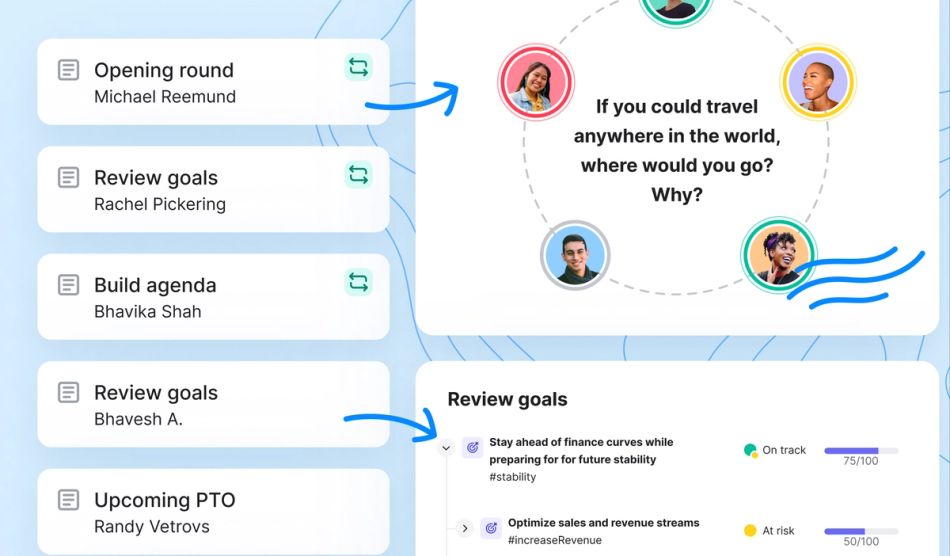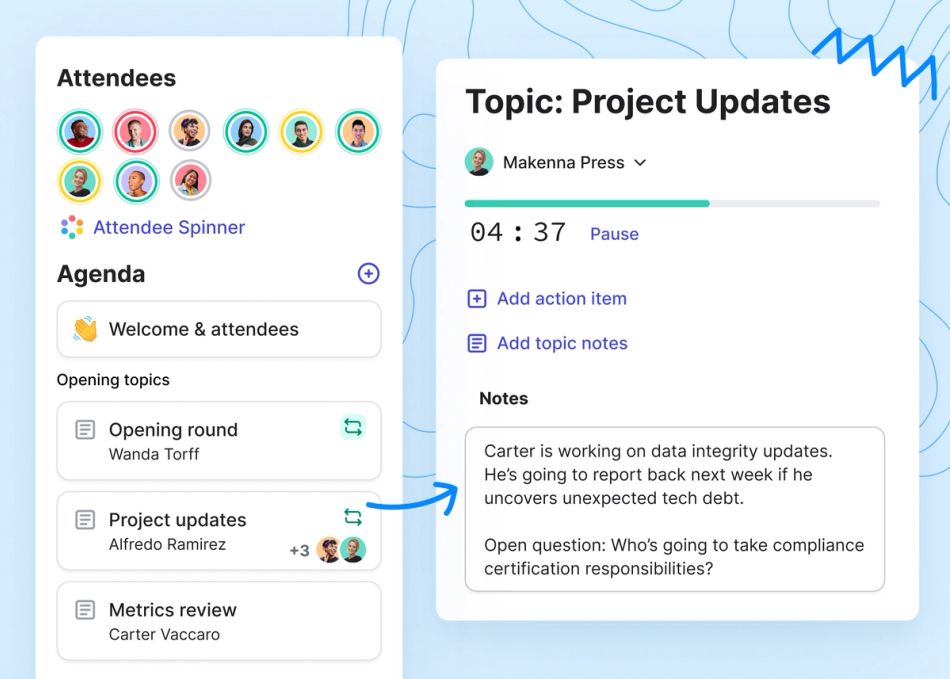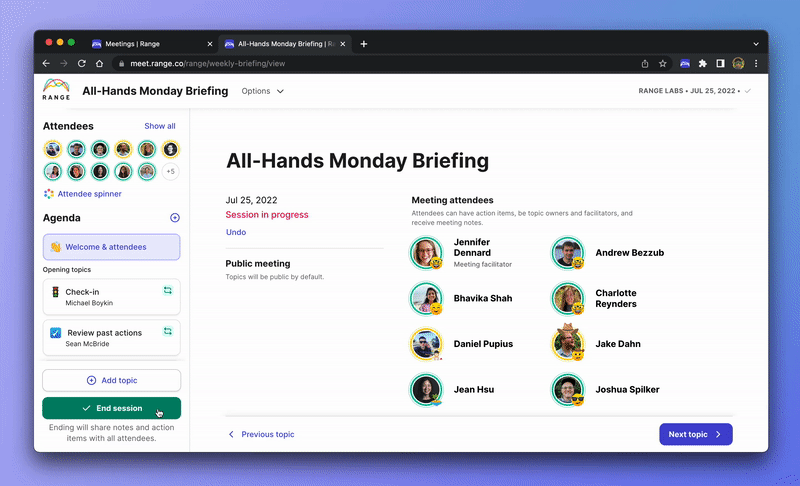
You want to make the most of the meetings you lead.
And that means setting agendas, taking meeting notes, and coordinating on action items. Fellow.app can do those things, but if you're looking for an alternative, these tools can help.
About Fellow
Fellow is a tool that helps meeting attendees improve effectiveness through greater team collaboration. Many managers use Fellow for one-on-one meetings as well, thanks to its ability to track and record decisions and enhance accountability.
Fellow allows users to assign action items during meetings and request feedback after each meeting.
It’s a great way to save time on both meeting preparation and meeting follow-up. It’s not quite a full-blown project management tool or suite, but it's effective as an online meeting management tool.
What are the best Fellow alternatives?
1. Range
Best for: Remote & hybrid teams who want to manage their meetings well, replace meetings with async options, and utilize goal-setting.
Too many meetings? Range is for you.
It was built to help teams run fewer, better meetings. With fewer meetings, your team will have more time to work together as a....um, team.
With multiplayer agendas, everyone can review and add topics before and during meetings, helping you capture all-of-the-things and keep conversations focused.
Icebreakers and attendee spinners create an inclusive environment that builds connections and ensures everyone gets their turn to share ideas and feedback. You can take notes and assign action items related to each topic in real time.
Plus, integrations with Slack and email that lets you pull topics into agendas, and easily distribute post-meeting notes and actions items to attendees (and the folks who just need visibility).
It will feel more inclusive for those times that you're together, and when you're apart, your team can check in asynchronously each day when work begins (replacing the traditional standup or in-person daily huddle).
With 75+ popular integrations, Range is the foundation your team needs to stay connected, and run better meetings.

Pros
- Plan in tandem with multiplayer agendas that integrate Slack & email
- Attendees can pull in topics in real-time
- Assign action items in real time and distribute notes async
- Use the spinner to ensure everyone has a chance to speak
- Integrate tools from across your workflow, including Slack, Github, Google Docs, Google calendar, Asana, ClickUp, and more
Pricing
- Free: Up to 12 users
- Standard: $8 per user per month
- Premium: Enhanced security features. Schedule your demo.
2. Hypercontext
Hypercontext is best for teams that want clearer, collaborative agendas and the ability to document meeting decisions and assign follow-up tasks in a permanent, accessible way that's not trying to be an all-in-one product.

Hypercontext can automatically send out meeting notes to all meeting attendees after each meeting, too, so everyone who was in the meeting gets all that valuable information.
Other features within Hypercontext include a database of conversation starters, a feedback platform, agenda templates, and a calendar.
It integrates with a very wide range of tools and platforms, including Microsoft 365, Google Workspace, Slack, Zapier, Cisco, and many others.
Pros
- Document decisions and assign tasks during meetings
- Automatically sends meeting notes to increase visibility, understanding, and accountability
- Integrates widely with the tools you’re already using
Pricing
- Basic: Free
- Small team starter plan: $5.00 per month (up to 5 users)
- Pro: $5.60 per user per month
- Business: $8.80 per user per month
3. Hugo
Hugo allows teams to hold centralized meetings where participants can share their notes in real time. Hugo makes it easy to share notes, stay organized, and make meetings more productive. Hugo has a library with more than 100 templates, with the a nice note-to-calendar functionality.
Pros
- Multi-user notes with search and filter features
- Integrates with over 20 work apps, and thousands more through Zapier
- Basic plan is free; the paid plan is per user
Pricing
- Basic: Free up to 10 users
- Pro: $6.00 per user per month up to 25 users
- Business: Custom quote
4. Notion
Notion gives its users a way to take notes and clip web information, which is especially useful when collaborating on a meeting. You can create structured notes and then change and share them easily across in-house or async teams.
Notion is a more comprehensive doc platform than a tool like Fellow, allowing you to create to-do lists, write, or set up tables. It's a flexible tool for multiple types of work.
Pros
- Easy to design integrated templates
- Note-linking feature assists organization
- Shared lists increase project visibility for each team member
- Plenty of company-provided tutorials and user guides
Pricing
- Personal: Free for individuals
- Personal Pro: $4.00 per month for individuals
- Team: $8.00 per user per month
- Enterprise: Custom quote
5. Coda
Very simillar to Quip or Notion, Coda is a flexible document platform that has multiple use cases -- including meeting notes and templates for one-on-ones all the way to staff meetings. Because of that flexibility, you can assign tasks directly from docs, create tables and spreadsheets, track projects. This wide open spaces approach is its top selling point, but could be a drag for teams that want more organization and structure to their meetings.
A more specific meeting management tool like Range will provide that much-needed structure and not become a catch-all.
Pros
- Flexible document for projects, writing, or analysis
- Features many doc templates to use for a variety of projects
- Can include action items along with goal-setting: it depends on how you create your Coda docs!
Pricing
- Free
- Pro: $10/month for doc makers
- Team: $30/month for doc makers
- Enterprise: Custom
6. Chanty
Chanty is another all-in-one meeting scheduling and collaboration tool that's very similar to Slack or Teams, in addition to other features like note-taking or goals. Share text, audio, and video along with support for both audio calls and videoconferencing.
Chanty includes support for sharing code snippets and saving pieces of content via a pin system as well. Kanban board integration allows for agile workflow tracking, which is a plus for agile teams.
Chanty is best for smaller teams that are not into Google Workspace or Microsoft Office. If you're wanting additional team chat features outside of the meeting notes in Fellow, then Chanty could be a solid option.
Pros
- Solid lightweight tool for messaging, videoconferencing, and scheduling
- Can assign tasks from within meetings
- Code snippet sharing
Pricing
- Free: Up to 10 users
- Business: $3.00 per user per month

7. Magic Minutes
Magic Minutes does most of the standard meeting management tasks that others can do, but is perfect for meeting minutes. If this is a core use case for you, then Magic Minutes will shine more than many of the other options on these lists.
This is for teams and organizations that need detailed meeting minutes and struggle to create them manually and is far more powerful than a basic tool like Word or Google docs.
You'll be able to create agendas, meeting notes, and make official meeting minutes very fast. Have phrases that are used often? Program Magic Minutes to take care of that for you and even capture whiteboard content directly into meeting minutes.
You'll be able to schedule follow-ups and also send out the meeting minutes after the session is over.
Pros
- Offers plenty of integrations with other productivity and collaboration tools, including Slack, Trello, Zenkit, and Zapier
- Free for attendees; paid accounts are only required for meeting organizers
Pricing
- Free: For meeting attendees only
- Team 10+: $6.03 per user per month (for larger organizations)
- Premium: $12.06 per user per month
- Enterprise: Custom plans are available for teams with more than 10 users.
8. Evernote
Evernote is still chugging along, and remains a reliable option especially for note-taking across multiple devices and surfaces. The app is one of the most popular and trusted names in the note-taking space. It shines as a personal meeting notes tool for work or personal use, and gives users the ability to keep everything in one place. Notes can be quickly shared to individuals or teams.
If you need something more lightweight than Fellow, but want easy access across all devices, Evernote remains a top option.
Key features
- Allows you to organize the way you want your notes to look
- Web Clipper feature lets you add web pages, photos, images, and PDFs to your notes
- Web app (Evernote Web) is fully functional
Pros
- Great search functionality for all types of notes and file types
- Keep audio notes up to 25MB
- Allows you to organize the way you want your notes to look
- Web Clipper feature lets you add web pages, photos, images, and PDFs to your notes
Pricing
- Free: Up to two devices
- Personal: $7.99 per month (unlimited devices)
- Professional: $9.99 per month (unlimited devices + 20GB monthly uploads)
Criteria for choosing a Fellow alternative
Each company and team has its own processes for effective meetings. But are you efficient and maintaining a high level of productivity?
When thinking about a Fellow alternative or other meeting management software, consider:
- Can you create an agenda from multiple people on a team?
- How do you get everyone involved?
- What about action items and next steps after a meeting?
- How will your team adapt to a new tool?
- Is it simple to use?
- What's your budget?
- Is there additional training?
- What other cultural factors are important -- such as goal setting and cutting down on time spent in meetings?
- How does it integrate with your current tech stack?
What's important to your team in a Fellow alternative?
Many tools on this list allow for task assignment and tracking (almost like task management), while others offer other helpful features like goal-setting, async check-ins, company handbooks, and more.

Remember, that meetings aren't the end-all-be-all. Async check-ins could be a way to cut down your time spent in meetings, a feature that Fellow doesn't offer. These align your team before the meeting even starts, and works great across time zones.
Range is the most powerful meeting management app for many teams — especially remote teams with asynchronous communication needs.








